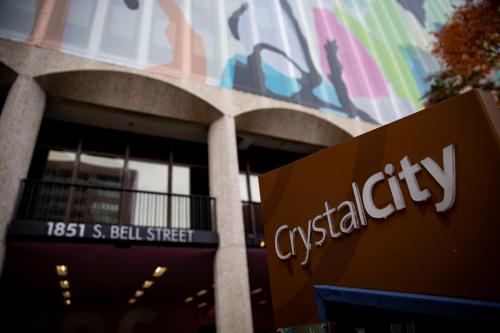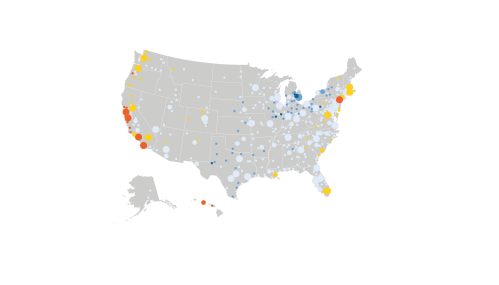With the news of Amazon’s new headquarters in Northern Virginia, concerns arise around what rising real estate values will mean for current residents. Prior analyses have suggested that Amazon’s arrival will put additional stress on the region’s housing market, but that the metropolitan area can accommodate the expected growth. In this article, we examine possible impacts on two neighborhoods closest to the National Landing headquarters in Northern Virginia—Arlington County and the City of Alexandria—which are likely to experience the largest direct effects. We focus particularly on economically vulnerable populations: low- to moderate-income renters who have few affordable options in the Washington, D.C. metro’s tight housing market. How resilient will current residents near National Landing be to rising rents?
Most National Landing residents can withstand rising rents
National Landing is a new name for the area around Amazon’s proposed campus, comprising part of several existing neighborhoods in southern Arlington County and the northern edge of Alexandria: Potomac Yards, Crystal City, and Pentagon City. About 24,000 people live within the six census tracts that make up National Landing.
Compared with the Washington, D.C. metro area overall, current residents of National Landing are highly educated and quite affluent (Figure 1). Nearly 90 percent have a bachelor’s degree or higher, compared to about 51 percent in the D.C. metro. Most of the affluent residents are young households without children, and have recently moved to the location. Renters occupy three-quarters of the housing in National Landing. Even before Amazon began its yearlong search, median rents in the neighborhood were relatively high compared to the D.C. metro area overall (around $2,000 per month in National Landing compared to just over $1,400 in the metro area, according to the most recent American Community Survey data). Because the current residents of Crystal City, Pentagon City, and Potomac Yards are economically well off, even if they face rent increases in the near future, they can probably afford decent quality housing in other desirable neighborhoods.

But National Landing is close to more economically vulnerable communities
The area immediately surrounding National Landing, known as Arlandria—a hybrid of the two jurisdictions’ names—is an ethnically and economically diverse community (Figure 2). The northern half of Arlington County is quite affluent. The neighborhoods around Metro’s Orange Line stations consist of expensive, high-rise apartments and condominiums. North of the Metro line towards the Fairfax County border are single-family neighborhoods served by some of the region’s best public schools. The southern half of the county, below U.S. Route 50 and where National Landing is located, has historically been more ethnically diverse and less affluent than North Arlington, with large Hispanic and Asian populations (Figure 3).
The City of Alexandria, which contains the southern tip of National Landing, is also economically and ethnically quite diverse, with a larger black population. Alexandria’s central Old Town neighborhood has an abundance of well preserved—and pricy—historic architecture. Alexandria’s northern and western neighborhoods, like South Arlington, have relatively large concentrations of “naturally occurring affordable housing”: older, garden-style apartments and small single-family homes that do not receive government subsidies but are nonetheless affordable to moderate- and lower-income families. Household incomes in Arlington and Alexandria vary substantially by race: black, Hispanic, and Asian families have significantly lower incomes than white families in both jurisdictions. Therefore, changes in the supply of affordable housing could have racially disparate impacts.


Figure 2 shows the share of housing units that rented for less than $1,500 per month in the most recent data. That is roughly the amount that a family earning 50 percent of the D.C. metro area’s median income could afford, if they spend 35 percent of their income on rent. These affordable neighborhoods and properties are likely to see rising rents—and possibly interest in redevelopment for higher-income tenant—as demand for real estate near National Landing grows. The residents of these neighborhoods—those with low to moderate incomes and lower levels of education, immigrants, and families with children—will face greater difficulty finding decent-quality housing that fits their budget.
Policymakers need to intentionally build and preserve diverse housing stock
As policymakers and business leaders in the greater Washington, D.C. region welcome the economic benefits from HQ2, they should also prioritize helping all residents share in those benefits. To maintain socioeconomic diversity, local governments across the region must plan for, and invest resources in, a diverse housing stock. There are three key prongs to a successful housing strategy:
- Preserve existing affordability by acquiring below-market apartments. The substantial stock of unsubsidized, low-rent housing in both communities offers an opportunity for local governments and affordable housing developers to purchase properties, and put into place long-term affordability protections. This strategy is particularly appropriate in regions like Greater Washington, where developing new affordable housing is extremely expensive. Arlington’s Affordable Housing Investment Fund can leverage private capital to do this. The newly launched Washington Housing Initiative, a partnership between the Federal City Council and JBG Smith (the firm that owns much of Crystal City, now National Landing’s, commercial properties), aims to increase investment in affordable housing preservation.
- Build more housing, more cheaply, in affluent neighborhoods. Moderate- and low-income neighborhoods in the Washington, D.C. metro area should not be expected to absorb all the demand for new, higher-cost housing. Over the past decade, affluent, mostly white neighborhoods in the region have not built their fair share, even of market-rate housing. That needs to change.
- Cooperate across jurisdictional boundaries. Amazon’s expansion will impact housing, labor markets, and transportation throughout the Greater Washington region. Local and state governments, corporate leaders, and nonprofit organizations need to move beyond lip service to regional cooperation, and commit to effective regional responses.








Commentary
Amazon’s Northern Virginia headquarters could exacerbate existing economic disparities
November 29, 2018